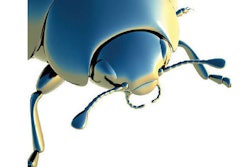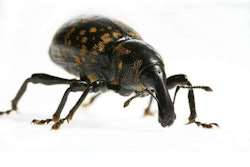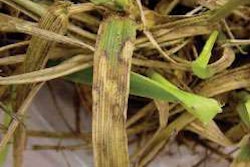How the loss of MSMA means more emphasis on pre-emergence control of weeds until a new alternative emerges.
By Cindy Ratcliff
Cocklebur, one of the weeds controlled by MSMA.For half a century, turfgrass managers have turned to monosodium methanearsonate (MSMA) as the post-emergence herbicide solution for some of their most challenging weed problems. So when the EPA cancelled the registration of MSMA for agricultural crops, including turfgrass, in 2009, it left a need for alternative products and management strategies that yield the same control.
Subsequently, managing hard-to-control weeds, such as dallisgrass, goosegrass and crabgrass, without MSMA proved more difficult, especially on warm-season turf grasses. While there are products offering good efficacy against the same weeds targeted by MSMA, they generally require more than one application and are more expensive.
Until researchers find the next best thing for post-emergence control, experts recommend a strategy based on an old standard: good cultural practices (aerification, fertility, irrigation, mowing, etc.) combined with an emphasis on pre-emergence control of weeds.
Back to basics
Healthy turf is less susceptible to disease and weeds, which can gain a foothold when turf is stressed.
“The best defense against weed invasion is maintaining a vigorously growing turf stand. Maximizing turf quality with proper cultural practices will help reduce weed invasions on the whole,” says Jim Brosnan, assistant professor of turfgrass weed science at the University of Tennessee.
The best defense against weed invasion is maintaining vigorously growing turf through good cultural practices.
“However, when herbicide applications are needed, selecting an alternative to MSMA will depend on what weed species you are trying to control,” he says. “In regard to crabgrass, the loss of an effective, economical post-emergence herbicide, like MSMA, makes pre-emergence control more important than ever.”
Luckily, there are other options that provide effective crabgrass control when used as part of an integrated weed management program, Brosnan says.
He recommends trying products such as prodiamine (Barricade), oxadiazon (Ronstar), dithiopyr (Dimension) and pendimethalin (Pendulum), which provide effective pre-emergence control of annual grassy weeds like crabgrass and goosegrass for extended periods of time.
 Two of the more challenging weeds controlled by MSMA: (top) goosegrass (below) crabgrass patches.
Two of the more challenging weeds controlled by MSMA: (top) goosegrass (below) crabgrass patches.
“Weeds like dallisgrass are more challenging in that certain herbicides will provide suppression, but few provide complete control,” Brosnan says. “Eradication with current technology requires multiple applications during several growing seasons.”
Prognosis for post-emergents
Currently, research is concentrated on evaluating new chemical compounds, as well as combinations of existing compounds, that will help soften the blow of losing MSMA.
But other avenues are also being explored. While University of Tennessee researchers evaluate the efficacy of experimental herbicides against weeds controlled by MSMA application, they’re also looking at how meteorological data can be used to determine points in the growing season where difficult-to-control weeds, such as dallisgrass, are most susceptible to various herbicidal modes of action.
This research indicates the optimum time to initiate a dallisgrass-control program is during the fall, when the average daily air temperature falls below 72 degrees Fahrenheit.
Post Emergence Alternatives
While MSMA can no longer be sold for use on residential, sports or commercial turf, existing supplies in the hands of turf managers can still be used, providing that the label is in compliance. If you still have reserves of MSMA, Brosnan’s advice is to use them against annual grassy weeds.
“This point especially rings true for dallisgrass, as there are no good options other than MSMA for selective post-emergence control of dallisgrass in turf,” he says.
“Herbicides such as foramsulfuron (Revolver) and trifloxysulfuron (Monument) will provide only dallisgrass suppression, not control.”
For cool-season turfgrasses, the lack of MSMA hasn’t significantly altered weed-control programs. “We were never a large proponent of MSMA,” says Forrest Martin, president of LushLawns, a treatment-based operation serving the Triangle-area market in North Carolina. “We live in a tall fescue market, and when there is a breakthrough of crabgrass here, it is in the dead of summer. By that time, fescue is under such stress that MSMA would damage it, even though it would knock out the crabgrass: just one of the challenges of living in the transition zone [for fescue].”
Instead, Martin uses Drive XLR8 selectively to treat weed breakthrough. “It does a good job and is kinder to the fescue, so we prefer it,” he says.
For cool-season turfgrasses, the lack of MSMA hasn’t significantly altered weed-control programs.
In warm-season turfs, another herbicide, Celsius, is becoming a popular alternative. Stephen Caracciolo, owner of Turf Medic in Wilmington, North Carolina, says it is his go-to herbicide for managing weeds on client properties.
“We like Celsius because it controls a variety of weeds,” says Caracciolo, a North Carolina Certified Turfgrass Professional. “I’ve been happy with the results. You can use high rates even in the summer, and there are no heat restrictions.” He also uses Drive and Revolver to eradicate centipedegrass and bermudagrass.
For some contractors, the transition away from MSMA will be more difficult, depending on their region.
With nearly 90 end-use products that contain MSMA, one thing is for sure: MSMA’s successor has potential to have broad appeal for weed control.
Why MSMA Was Banned
MSMA contains an organic form of arsenic that is relatively nontoxic. However, in an inorganic state, arsenic is highly toxic. And in 2006, water samples from some golf courses in Florida tested high in arsenic, which prompted the EPA to cancel the registration for ag use. There was a concern that the organic arsenic from MSMA could convert to the more toxic, inorganic form in the environment.
MSMA Comeback?
Goosegrass in bentgrassAs part of its ruling on MSMA herbicides in 2009, the EPA stipulated distributors could continue selling these products to golf courses until June 30, 2013 (for restricted use). Subsequent use of all MSMA products on golf courses will be prohibited. However, the EPA has agreed to further evaluation that could extend MSMA registration.
“The EPA has agreed to conduct a scientific review in 2012 evaluating available information describing the mode of action of MSMA and benefits conferred by its use as a herbicide,” says Jim Brosnan, assistant professor of turfgrass weed science at the University of Tennessee. “If this review is favorable, use of MSMA on golf courses, sod farms and highway rights-of-way may continue beyond 2013.”
However, there are no indications the EPA will reconsider expanding MSMA herbicide registration to include use on residential and commercial turf, even if the scientific review results in continued use on sod farms, rights-of-way and golf courses.









